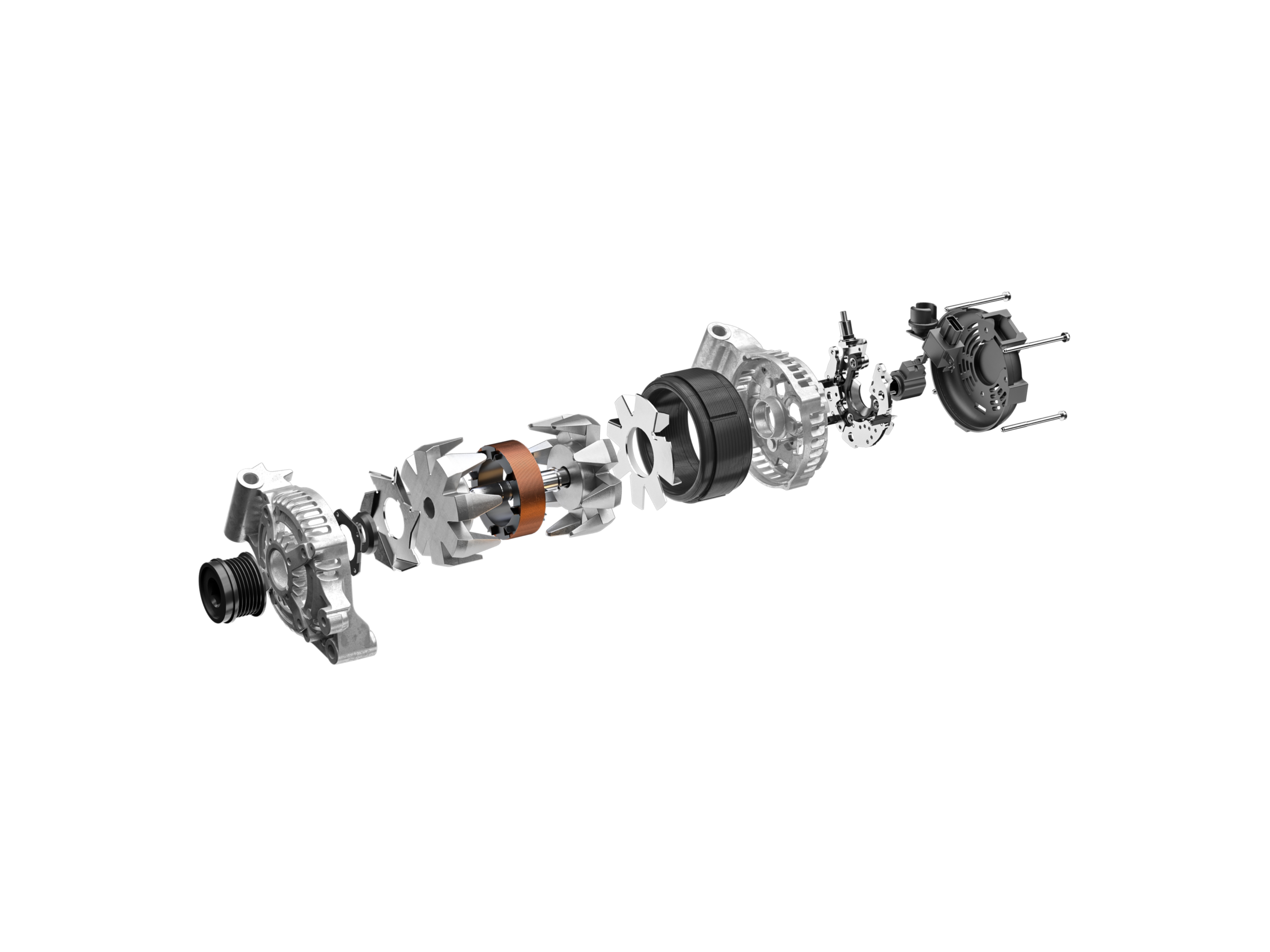What parts influence the quality and lifespan of an alternator? Before you buy car alternators, learn about the parts of an alternator and their functions in depth and then choose the right alternator.
What is an Alternator in a Car
As a “charger” in a vehicle, the alternator generates electrical energy for the battery and electrical accessories. It converts mechanical energy into electrical energy. When the charge system is activated, the alternator is driven by the belt attached to the engine crankshaft and starts to generate.
What are Alternator Parts
The basis of alternators is electromagnetic induction. The battery provides a small current to energize the magnetic field and the metal conductor cuts the magnetic field lines, generating the AC (alternating current). Every part functions to complete the process. The parts names are following:
Rotor
The rotor is an electromagnet that is a magnetic metal wrapped with copper wires inside the alternator. The rotor spins along with the engine and interacts with the stator to create AC.
Stator
The stator surrounding the rotor is stationary during operation. It consists of an iron core made of laminated silicon steel and copper windings around the core. For circuit safety, the engineers apply the techniques of varnishing and dipping to electrically isolate the stator from the alternator housing. 89%
Carbon Brush and Slip Rings
Carbon brushes and slip rings deliver the field current to the rotor. The carbon brushes are mounted on the stator assemblies. As the slip rings constantly rotate, the brush springs are designed to tightly contact the slip rings. To further transfer current efficiently, the slip rings are often made of copper alloy and are precision-machined.
Rectifier
A rectifier typically consists of six diodes and each one has both cathode and anode terminals. The current only flows from the anode to the cathode in one direction, so the diode can convert AC to DC. This is the main function of the rectifier. To dissipate heat generated by the current flowing, the diodes are mounted on the heat sink to protect the alternator from overheating.
Clutch Pulley
When the engine starts, the clutch pulley transmits the power to rotate the rotor efficiently. In particular, it disengages to protect the engine from being turned backward by the alternator when the engine speed drops suddenly. The clutch pulley often lasts 6,000 km ~10,000 km (3~5 years) during operation. If you have a high-quality clutch pulley, its lifespan may last over 12,000 km.
Voltage Regulator
A voltage regulator monitors the battery’s voltage. If it’s high, the alternator maintains or reduces the original power output. Conversely, the alternator needs to produce more electricity to recharge the battery. In this case, the voltage regulator allows more field current to the rotor, strengthening the magnetic field. An obvious sign of a faulty voltage regulator is the headlights flickering. For distributors or workshops, inspecting the regulator regularly can protect the battery and electrical system and also reduce the customer complaints effectively.
Bearings
Alternators generally have front/rear bearings (drive-end bearing/non-drive-end bearing). They are manufactured to provide support between the rotor shaft and the housing. Without these bearings, the direct contact causes sliding friction. Then it leads to the wear on core components, alternator overheating, and excessive energy loss. The function of the bearing is such that the rolling elements inside it replace the sliding friction with rolling friction, thereby solving these issues. Additionally, most bearings are lubricated to further minimize friction and prevent rust.
Rotor Shaft
The rotor shaft transmits the engine power to start the rotor assembly. To withstand tensile force and torque from the engine, it’s made of high-strength alloy steel. Many crucial components are mounted on the rotor shaft, such as slip rings, bearings, cooling fan and the rotor core. Many manufacturers apply a precision finishing process to the rotor shaft, ensuring compatibility with these parts.
Cooling Fan
A cooling fan is mounted on the alternator to dissipate heat when there are original vents on the housing. Whenever the alternator is running, it starts at the same time. For matching different alternators’ structures, there are external fans and internal fans. Based on the type of the cooling fan, the cost of labor can vary significantly.
Conclusion
After acquiring a fundamental understanding of the alternator part, you can source the right components. And it’s cost-effective to replace parts rather than the alternator assemblies.
FAQs
Is the Alternator Part of the Powertrain?
No, it belongs to the electrical system.
Is the Alternator Part of the Transmission?
No. Transmission is also a part of the powertrain.
Where to Buy an Alternator?
You can purchase it online, or go to an auto parts repair shop.




